What is Elon Musk's Starship space vehicle?
- Published
Watch the moment Starship's launch was halted
Elon Musk is developing a vehicle that could be a game-changer for space travel. Starship, as it's known, will be a fully reusable transport system capable of carrying up to 100 people to the Red Planet.
Mr Musk's private spaceflight company SpaceX tried to get Starship airborne on Monday, April 17 but postponed the launch because of a pressurisation issue.
SpaceX could try to launch again later this week. This article takes an in-depth look at the project.
Towards a 'Spacefaring civilisation'
The founding ethos of SpaceX was to make life multi-planetary. He says that settling humans on other worlds, such as Mars, could preserve civilisation if Earth were to experience a cataclysm, such as a large asteroid impact.
"History is going to bifurcate along two directions. One path is we stay on Earth forever, and then there will be some eventual extinction event," Musk said in 2016., external
"The alternative is to become a spacefaring civilisation and a multi-planet species, which I hope you would agree is the right way to go."
The SpaceX founder has often spoken about his dream of building cities on Mars. He believes that settlements would need large numbers of people in order to become self-sustaining.
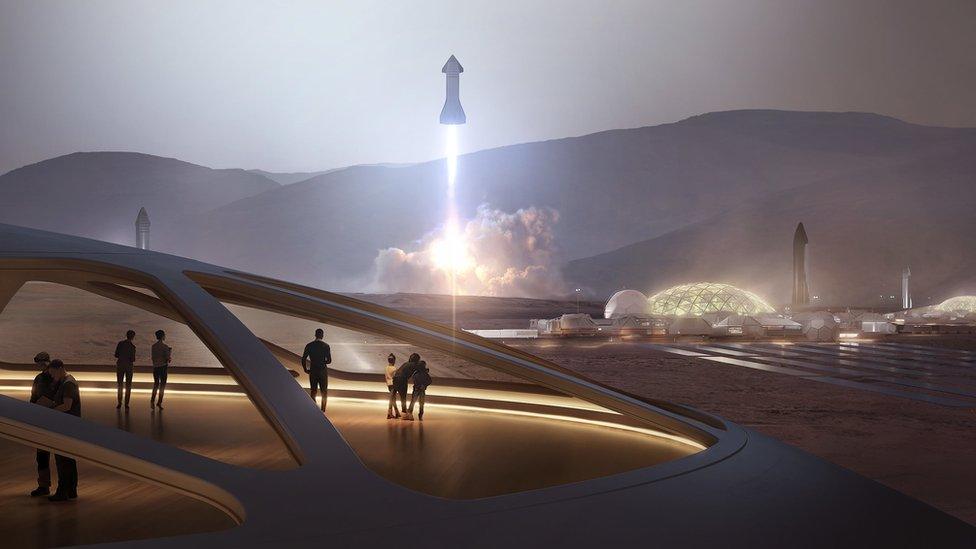
Musk has spoken of building cities on the Martian surface
Realising this dream requires a vehicle that's up to the task. Starship is a rocket and spacecraft combination that could ferry more than 100 people a time to the Red Planet.
The system is designed to be fully and rapidly reusable. Being fully reusable means the principal hardware elements are not discarded in the sea or allowed to burn up, as happens with some other launch systems, but return to the ground so they can be flown again.
Rapid reusability means that after coming back from space, Starship can be re-filled with propellant and be ready to launch again in a short period of time - like an aircraft. This reduces the cost of the whole enterprise.
Starship: An overview
At launch, the spacecraft, called Starship, will sit atop a rocket called Super Heavy.
The combined system will stand 120m (394ft) -tall and is also referred to as Starship.
Let's take the spacecraft first. With its nosecone and landing fins, the stainless-steel vehicle resembles the rocket-ships from the golden age of science fiction.

At the rear of the 50m (160ft) -long craft are six highly efficient Raptor engines, developed over the course of a decade by SpaceX. The combustion takes place in stages, and the engine's design cuts the amount of propellant that's wasted.
Towards the middle of the vehicle are the propellant tanks. These feed liquid methane (CH4) and liquid oxygen (O2) to the Raptors.
Methane is the fuel and oxygen acts as an oxidiser - a chemical that makes the fuel burn. The combination is dubbed methalox.
The choice of fuel is unusual for rocket engines, but methane can generate plenty of thrust. It's also a prudent choice in light of Musk's designs on Mars. The SpaceX founder says that CH4 could be synthesised from Martian subsurface water and from atmospheric carbon dioxide (CO2), using a chemical process known as the Sabatier reaction.
Re-fuelling Starship for the return trip to Earth using Martian resources would confer a level of self-sufficiency, making journeys both more feasible and cost-effective.
Towards the front of the spacecraft - which is sometimes referred to as the upper stage - is a huge payload compartment that will be able to haul large cargo or people to destinations in deep space.
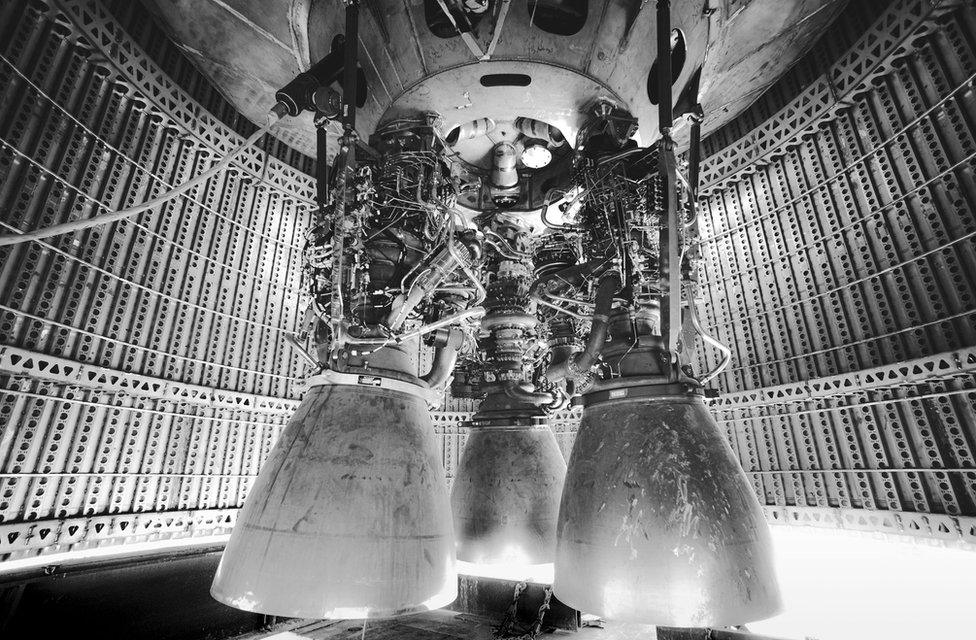
Starship is powered by Raptor engines, which burn methane as fuel
Now, let's turn to the rocket. Measuring 70m (230ft) -long, Super Heavy will be filled with cryogenic (chilled) methalox.
It will be powered by around 33 Raptor engines (this specification has changed several times) and should achieve more than 70 Meganewtons (16 million lbs) of maximum thrust. It should be able to lift at least 100 tonnes of payload, and possibly as much as 150 tonnes, to low-Earth orbit.
This will make Super Heavy more powerful than the immense Saturn V launcher used for the Apollo Moon missions in the 1960s and 70s.
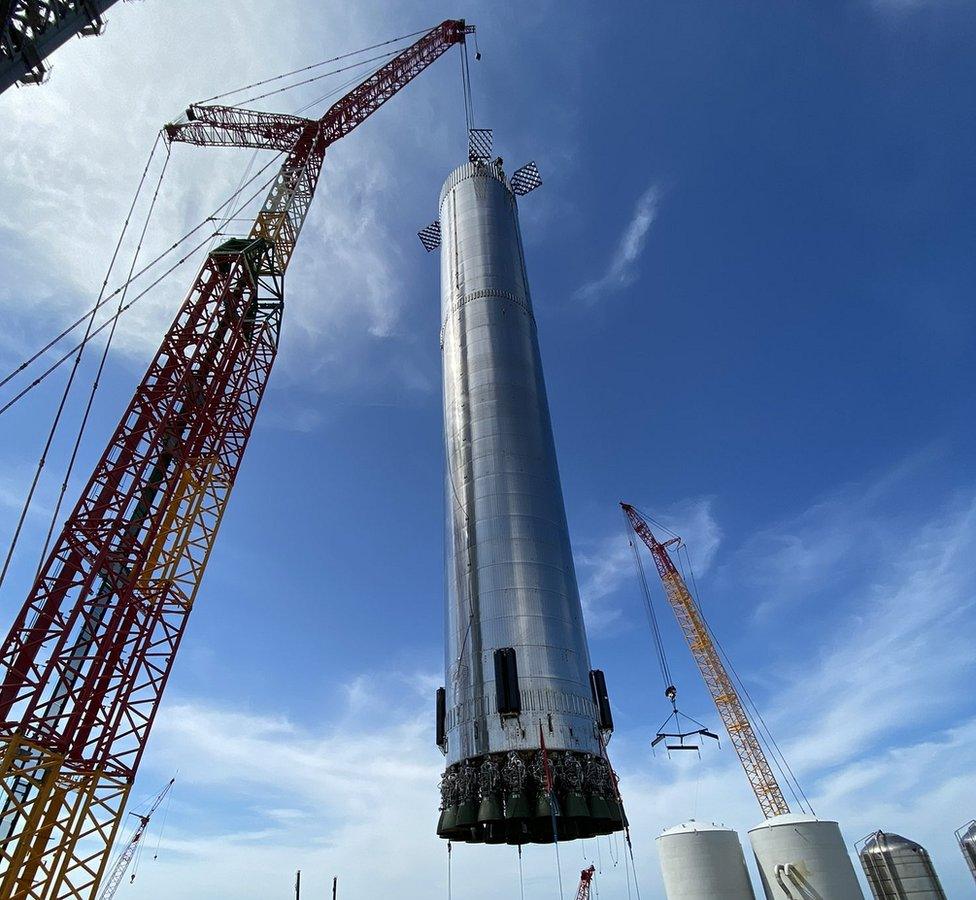
A Super Heavy booster is worked on at Starbase in Texas
Launch and re-filling
As it ascends from the launch pad, the combined Starship system will begin to pitch over towards the intended orbit.
When the upper stage separates in space, Super Heavy flips over while falling back towards Earth.
Steel structures called "grid fins" attached to the sides of the booster, will help steer the rocket stage back towards its launch pad so it can be flown again.
SpaceX has an ambitious plan to then catch the falling booster using its launch tower.
This tower provides engineers and crew members with access to the spacecraft and rocket while they are sitting on the pad before launch.
A pair of steel arms will extend out from the launch tower. The spent booster falls onto these arms. The tower has been dubbed "Mechazilla" because of its resemblance to a creature from the Godzilla movies.
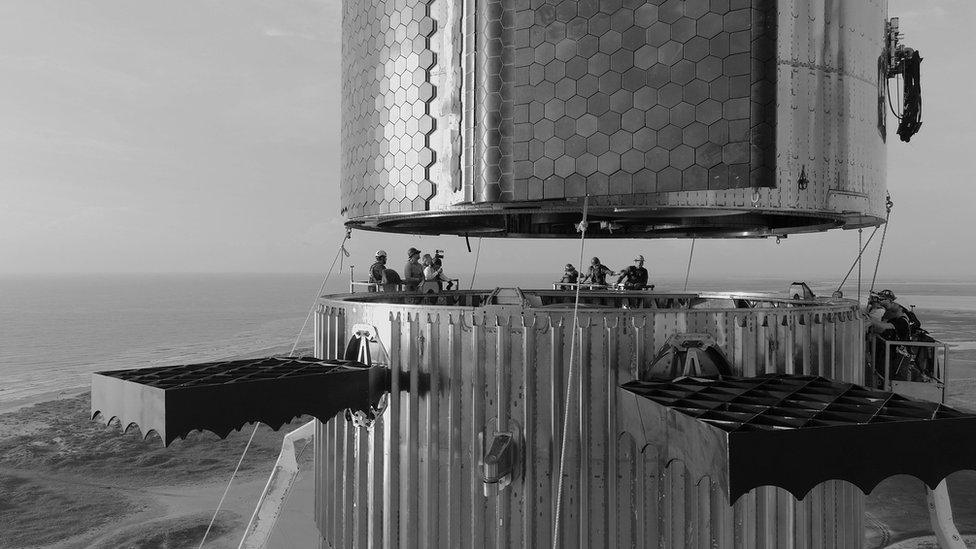
An evocative photo of Starship being stacked on Super Heavy. The grid fins sticking out from the booster help steer it back to Earth
Meanwhile, the Starship upper stage could be inserted into a "parking orbit" after separation, allowing it to be re-filled with propellant.
"If you just fly [Starship] to orbit and don't do any refilling, it's pretty good — you'll get 150 tonnes to low-Earth orbit, and have no fuel to go anywhere else," Musk explained in 2017.
"If you send up tankers and re-fill in orbit, you could re-fill the tanks up all the way to the top, and get 150 tonnes [of payload] all the way to Mars."
To re-fuel, the spacecraft would dock with another Starship - already circling the Earth - that acts solely as a propellant depot.

What will Starship be used for?
For long-haul trips to Mars and back - which could take up to nine months each way - Musk is looking to install around 40 cabins in the payload area near the front of the upper stage.
"You could conceivably have five or six people per cabin, if you really wanted to crowd people in. But I think mostly we would expect to see two or three people per cabin, and so nominally about 100 people per flight to Mars," Musk said.
The payload bay would also host common areas, storage space, a galley and a shelter where people could gather to shield from solar storms, where the Sun belches out harmful charged particles into space.
Starship will also play a key role in Nasa's Artemis programme, which aims to establish a long-term human presence on the Moon. In April 2021, the US space agency awarded SpaceX with a $2.89bn contract to develop Starship into a lander capable of delivering astronauts to the lunar surface this decade.
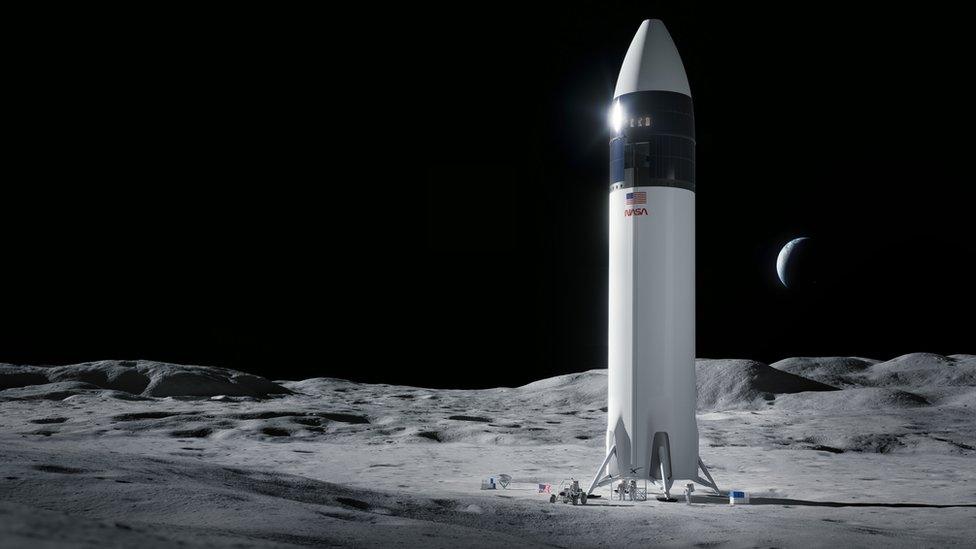
Starship will land humans on the Moon for the first time since 1972
The version tailored for Artemis flights, external would not possess the heat shield or flaps that are necessary for a return journey to Earth. Instead, the Starship Human Landing System would remain in space after its initial launch from Earth, so that it could eventually be used for multiple trips between lunar orbit and the Moon's surface.
The uncrewed, or cargo, version of Starship features a payload bay that opens up like the mouth of a crocodile. This would allow it to be used for launching satellites. SpaceX says the huge payload capacity opens up possibilities for new types of robotic science mission, including telescopes larger than the James Webb observatory - the successor to Hubble which launched in December 2021.
The system could also be used for space tourism: Elon Musk has promised a trip around the Moon in 2023 to the Japanese online retail billionaire Yusaku Maezawa. It could also carry out high-speed journeys between different destinations on Earth.
Musk says that Starship could eventually carry people to destinations in the "greater Solar System", including gas giants such as Jupiter. But this remains a long-term objective.
How does the upper stage land?
In order to bring other spacecraft back to the ground, engineers have relied on parachutes, or designed the vehicle so that it can land on a runway.
But the Starship upper stage takes a different approach. When it is ready to land on Earth, the ship initially re-enters the atmosphere at a 60-degree angle and then "belly-flops" to the ground in the horizontal position.
This mode of return relies entirely on the atmosphere, external to slow the vehicle's descent. The downside is that, in this configuration, Starship is inherently unstable.

Starship "belly flops" back to Earth before firing its engines to flip it into the vertical position
The vehicle therefore uses four steel landing flaps, positioned near the front and rear of the vehicle, to control its descent. This is much like a skydiver uses their arms and legs to control a free-fall.
"It's quite different from anything else… we're doing a controlled fall," Elon Musk says.
"You're trying to create drag rather than lift - it's really the opposite of an aircraft."
As Starship approaches the ground, it should be slow enough to execute an engine burn that flips the vehicle into a vertical position, external. It then uses the Raptors as retro-rockets to guide the vehicle down to a safe touchdown on its landing legs.
Musk says this general approach could be used to bring Starship down safely on any planetary surface in the Solar System.
Eventually, however, Starships returning to Earth - and perhaps other destinations - might not have to do the flip manoeuvre. The ships could instead be captured as they approach the ground by the launch tower's steel arms - just like the Super Heavy booster.
Musk explained on Twitter, external: "Ship will be caught by Mechazilla too. As with booster, no landing legs. Those are only needed for Moon and Mars until there is local infrastructure."
When will it fly?
In the last few years, SpaceX has tested various prototypes of the upper stage at its Starbase facility in Boca Chica, Texas.
The company started off in 2019 with a 39m-tall "test article" called Starhopper - which bore a passing resemblance to a water tower - and flew it to 150m above ground.
SN15 launched with improvements in its structures, avionics, software, and engines
The first prototype to feature a nosecone and flaps - Starship serial number (SN8) - flew to an altitude of 12.5km in December 2020. It belly flopped back to Earth, giving SpaceX valuable engineering data about the final part of the vehicle's return from space.
However, SN8 approached the landing pad a little too fast and hard, causing it to crumple and explode. Three more test articles exploded before Starship SN15 achieved success with a soft landing in May 2021.
In February, SpaceX engineersconducted a key test on the rocket system, what's called a "static fire", simultaneously igniting 31 out of 33 of the engines at the base of the vehicle's lower-segment.
The firing lasted only a few seconds, with everything clamped in place to prevent any movement.
Mr Musk tweeted that the team had turned off one engine before the test and that another engine stopped itself, leaving 31 engines firing overall.
But, he added, it was "still enough engines to reach orbit"
The FAA granted a license that would allow SpaceX to perform a test flight for the rocket, which is scheduled for 17 April.
"After a comprehensive license evaluation process, the FAA determined SpaceX met all safety, environmental, policy, payload, airspace integration and financial responsibility requirements," the FAA said in a statement on Friday, adding that the license was valid for five years.